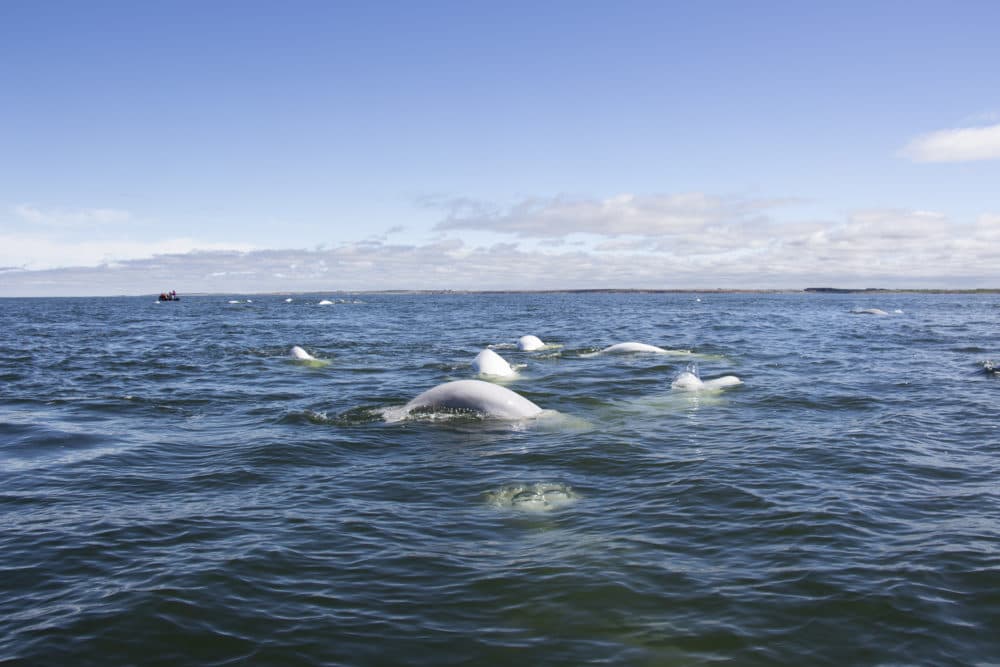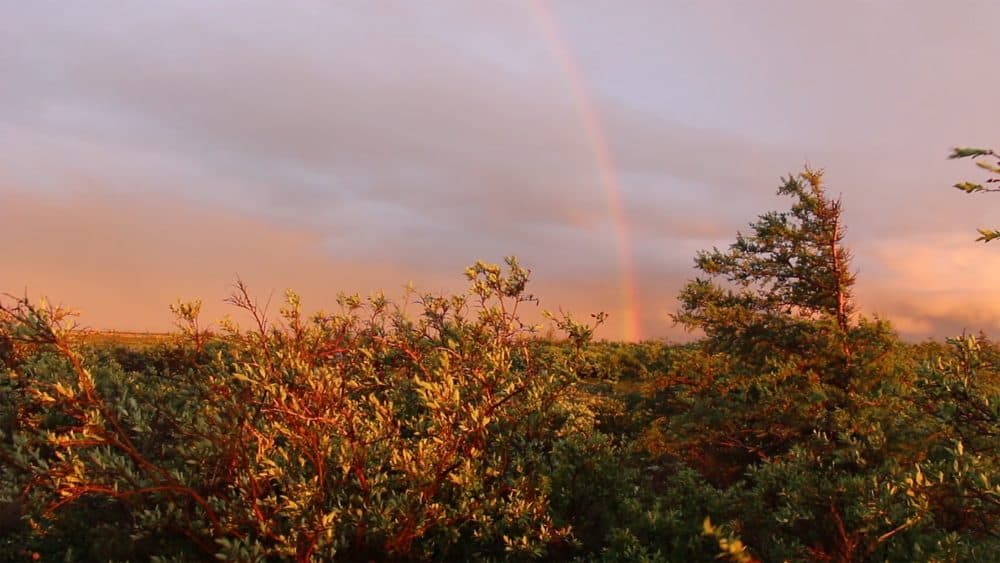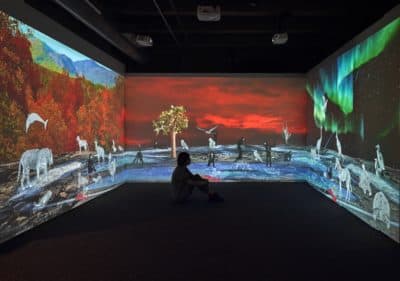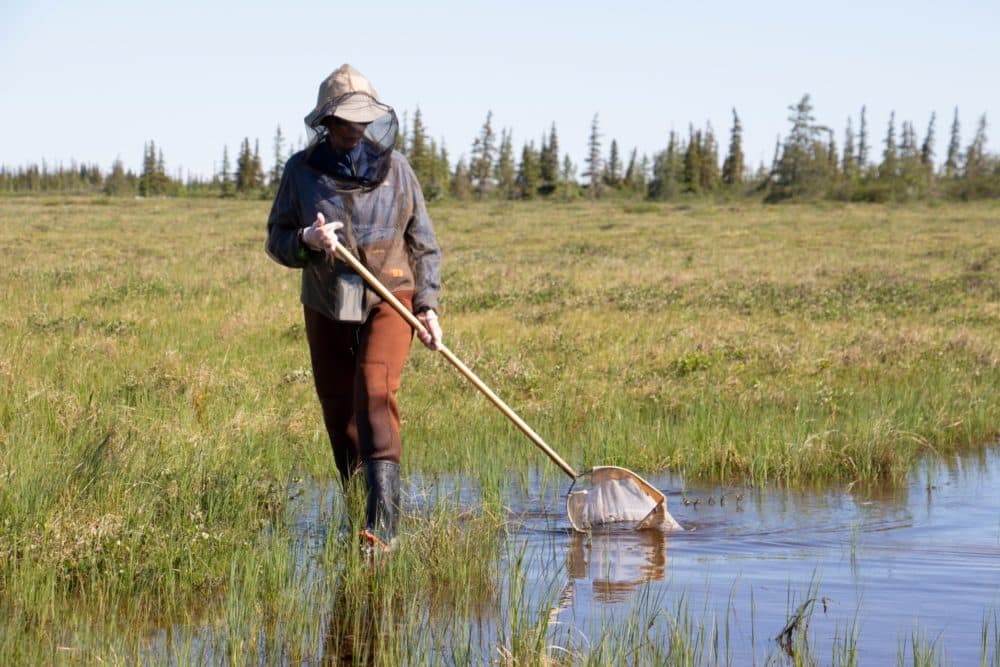Advertisement
An Artist's Notebook: Recognizing The Unseen

This is the second in a short series of notebook entries from Boston-based interdisciplinary artist Allison Maria Rodriguez, who focuses her work on environmental issues. She traveled to Churchill Northern Studies Centre in Manitoba this summer on an Earthwatch Fellowship to engage in the scientific process and gather inspiration. Read Notebook #1 here and read her thoughts a few months later below:
“That’s when I looked him right in the eye ... and I asked for his permission to do this project, to make my film," explains artist Maryse Goudreau. "I’m not sure what he said, because I don’t understand beluga language, but at least I asked.”
Goudreau has been creating an archive of the beluga whale's social history for the past six years. Lucky for me, her work brought her to the Churchill Northern Studies Centre (CNSC) during my Earthwatch Fellowship this summer. She was specifically interested in how humans interact with the whales, both personally and culturally — and I learned a lot by observing how she connected with them.
The belugas of Churchill are very engaged and responsive to humans, especially human singing. While kayaking with them in the Hudson Bay, I had what can only be described as a small panic attack; I could feel their presence so viscerally while simultaneously being aware of the pain we are causing the earth. I started crying.
Later during the fellowship, I was giving an artist lecture at the CNSC to a room of about 60 scientists, researchers, educators and science students — definitely a different audience than I am accustomed to. I was concerned they’d ask me questions regarding data, species, dates, habitats — fact-based questions that I couldn’t answer. Instead I got, “Your work is amazing, but it’s really vertebrate heavy. Why don’t you make work about invertebrates?” The scientist that asked this question studied caddisfly and I could hear it in the tone of his voice: He was asking me a question driven by his emotional connection. It wasn’t about facts, it was essentially, “Why don’t you care about these animals that I care so deeply about?” It was a great question, it just wasn’t what I expected.
Advertisement
We don't often talk about the connection between hard science and spirituality, but the connection was evident in the way these scientists relate to their subjects and the planet. There is a reverence in the way they talk about whales, frogs, birds, daphnia or caddisfly. There is an awareness of the overall balance of the universe — a wholeness or a oneness — and if that isn’t spirituality, I don’t know what is. And I find it in my own practice as well. It's often assumed that an artist’s art changes in correspondence with their life, and though that is certainly true, in my experience so is the inverse: My art has also changed my life. As an environmental activist, by pursuing these crucial issues in my artwork, I have also come to a new place of spiritual awakening.

One of the strongest creative inspirations I had in Churchill was the sense that it was not just Churchill I was standing in, but our collective future. The constructed micro/macro way we tend to relate to the world was dissolved for me, and I am currently creating an entire room filled with what I call dancing light — a large scale moving “wallpaper” projection involving animated drawings of daphnia (water fleas) and other larger than life microorganisms. I am also developing a video installation titled “All That Moves.” This piece involves projecting imagery of the warming Hudson Bay waters onto slowly melting ice from New England (or from wherever the work may be installed), surrounded by candles and memorial iconography. It is the same water in both locations, as it is the same water that contributes to 60 percent of an adult human’s body weight. It is our shared existence — and as those waters warm it is our shared struggle for survival.

The aesthetics in this work is rather different than some of my other work, as I respond to the experience and react instinctively to what the materials and the environment ask of me. I also felt compelled to record the northern landscape around me — and that is not a common response for me. I don’t document landscapes; I create them. But in Churchill I had the impulse to set up a tripod and simply document (in video) the wind, the rain, the bugs, the empty space, the passing of time — the movement in such a still and quiet place. Artist Carrie Mae Weems has stated, “If you get out of the way of your work, your work will tell you exactly what it needs.” I've found that to be very true of my process. My work tends to be very labor intensive and technical, but there is also an element of flow and intuition in the process. From this documentation I created a video installation titled “We Dropped Something,” involving cultural commentary on the United States’ relationship to the north, but I feel as though I am just starting to explore the material and am excited to see where all this footage leads.
During my time at the CNSC, I was not just an artist, but also a field worker, a researcher, an analyst and a teammate. My team was comprised of seven other individuals, all youth educators on Earthwatch teaching fellowships. Our team was tasked with sampling 22 natural ponds, accumulating a wide range of data about each pond that could be compared over many years, and for assisting with a study on the movement patterns of wood frogs in relation to moisture. In July, field work in Churchill is both beautiful and disgusting. There is nothing quite like taking in the crisp clean air and breathtaking landscapes while covered in mud, sweat, mosquito guts and feces. I can honestly say I wouldn’t change a thing.

A moment that still stands out in my mind happened late one day. We were heading to our third pond of the day, and one of the teachers said to me, "Listening to you talk, I’ve realized that facts aren’t enough. There needs to be some emotional, or spiritual, connection to really get the kids invested. I’ve been thinking about it a lot — I need to approach teaching climate change differently to include this aspect." This made me smile, but I knew that I was definitely the lucky one. The commitment of these educators to future generations, the entire CNSC team, and this whole experience gave me hope — and hope is priceless.
Allison Maria Rodriguez is a Boston-based interdisciplinary artist working predominately in video installation. Her work is currently on display locally at Fountain Street Gallery and 13FOREST Gallery.